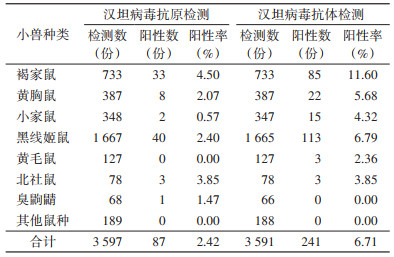扩展功能
文章信息
- 王敏, 杨辉, 余樟有, 钟建跃, 方春福, 吴世泉, 龚震宇
- WANG Min, YANG Hui, YU Zhang-you, ZHONG Jian-yue, FANG Chun-fu, WU Shi-quan, GONG Zhen-yu
- 浙江省衢州市2006-2020年肾综合征出血热人群流行特征及宿主动物监测研究
- Epidemiological characteristics of hemorrhagic fever with renal syndrome and surveillance studies of host animal in Quzhou, Zhejiang province, China, 2006-2020
- 中国媒介生物学及控制杂志, 2022, 33(4): 480-484, 509
- Chin J Vector Biol & Control, 2022, 33(4): 480-484, 509
- 10.11853/j.issn.1003.8280.2022.04.007
-
文章历史
- 收稿日期: 2022-03-10
2 衢州市疾病预防控制中心传染病防治科, 浙江 衢州 324000;
3 浙江省疾病预防控制中心传染病预防控制所, 浙江 杭州 310051;
4 杭州医学院公共卫生学院, 浙江 杭州 310000
2 Department of Infectious Disease Prevention and Control, Quzhou Center for Disease Control and Prevention, Quzhou, Zhejiang 324000, China;
3 Department of Infectious Disease Control and Prevention, Zhejiang Provincial Center for Disease Control and Prevention, Hangzhou, Zhejiang 310051, China;
4 School of Public Health, Hangzhou Medical College, Hangzhou, Zhejiang 310000, China
肾综合征出血热(hemorrhagic fever with renal syndrome,HFRS)是一种由汉坦病毒引起的以鼠类为主要传染源的自然疫源性疾病,该病流行范围广,不及时治疗会对人体产生严重危害。据史料记载,浙江省衢州市曾是日军侵华战争中实施细菌战的重灾区,造成鼠疫疫情持续多年暴发。20世纪60年代以来,该地区一直是浙江省HFRS的重点发病地区[1]。经过科学防鼠灭鼠等一系列综合防治措施后,2002-2004年发病有下降趋势[2]。为了解HFRS疫情形势及今后更有针对性地开展精准防控,本文对2006-2020年衢州市HFRS发病资料及监测点小兽监测资料进行了统计分析。
1 材料与方法 1.1 资料来源HFRS病例资料从中国疾病预防控制信息系统获得,人口资料来源于衢州市统计局统计年鉴。
1.2 宿主动物监测分别在龙游县、江山市、开化县设立监测点,在HFRS发病高峰前1个月用夹夜法开展小兽密度监测。室外沿一定地势布放鼠夹,夹距5~10 m,连续布放3 d,每天至少100夹;选择居民住宅区进行室内监测,每天选择至少20户,每户布放5夹,连续布放3 d,计算捕获率及进行小兽种类鉴定。
1.3 标本采集及实验室检测无菌采集小兽肺和血,分别用直接免疫荧光法(DFA)及间接免疫荧光试验(IFA)检测其汉坦病毒抗原和血清汉坦病毒抗体,计算小兽带病毒率及抗体阳性率。
1.4 统计学分析利用WPS 2020软件建立数据库,计算HFRS发病率,利用SPSS 20.0软件进行统计学分析,率的比较采用χ2检验,采用Spearman相关性分析进行小兽密度与HFRS发病率相关分析,P < 0.05为差异有统计学意义。
2 结果 2.1 流行概况2006-2020年衢州市共报告HFRS病例720例,年平均发病率为2.13/10万(1.09/10万~3.36/10万)。共报告死亡病例2例,病死率为0.28%。3个监测点共报告HFRS病例475例,占衢州市报告病例总数的65.97%(475/720),其中开化县361例,年平均发病率达8.81/10万,为全市最高。各县(市、区)发病数及发病率见表 1。

|
2006-2020年总体来看,每月均有HFRS病例出现,且每年10月至次年1月为HFRS流行强高峰期,占病例总数的47.36%(341/720);5-7月为流行小高峰,占25.56%(184/720)。见图 1。

|
| 图 1 2006-2020年浙江省衢州市肾综合征出血热病例数随时间变化趋势 Figure 1 Changes over time in number of cases of hemorrhagic fever with renal syndrome in Quzhou, Zhejiang province, 2006-2020 |
| |
不同职业及各年龄段人群普遍易感。2006-2020年720例病例中,农民577例,占80.14%;工人39例,占5.42%;学生20例,占2.78%;离退休人员15例,占2.08%;其他人员69例,占9.58%。男性占70.14%(505/720),女性占29.86%(215/720),男女性别比为2.35∶1。各年龄组均可发病,发病年龄最小5岁,最大82岁,以30~69岁年龄组为主,占92.08%(663/720)。
2.4 小兽密度及其构成2006-2020年衢州市监测点共布放鼠夹60 534夹次,捕获小兽3 615只,小兽密度为5.97%(2.75%~8.68%)。其中室内布放17 922夹次,捕获小兽998只,密度为5.57%(1.90%~9.15%);室外布放42 612夹次,捕获小兽2 617只,密度为6.14%(3.03%~9.35%)(表 2)。室内小兽密度明显低于室外(χ2=7.374,P=0.007)。

|
室内优势种为褐家鼠(Rattus norvegicus),占41.18%,其次为黄胸鼠(R. tanezumi),占21.74%。室外优势种为黑线姬鼠(Apodemus agrarius),占62.97%,其次为小家鼠(Mus musculus),占7.56%。另外2008年在开化监测点内捕获黑腹绒鼠(Eothenomys melanogaster)16只(表 3)。室内、外小兽种类构成差异有统计学意义(χ2=1 343.773,P < 0.001)。

|
2006-2020年3个监测点中6种小兽肺抗原检测阳性,褐家鼠阳性率最高,为4.50%,共检测小兽肺标本3 597份,抗原平均阳性率为2.42%,不同种类小兽抗原检测阳性率差异有统计学意义(χ2=17.260,P=0.004)。抗体检测阳性小兽6种,其中褐家鼠抗体阳性率高达11.60%,其次为黑线姬鼠(6.79%),抗体平均阳性率为6.71%(表 4)。不同种类小兽抗体检测阳性率差异有统计学意义(χ2=32.923,P < 0.001)。

|
Spearman相关分析结果显示,2006-2020年衢州市3个监测点HFRS发病率与小兽密度呈正相关(rs=0.539,P=0.038)。
3 讨论衢州市自1965年有HFRS病例报告以来,各年代发病情况有所不同。20世纪60年代呈散发态势,70年代发病率虽有所上升,但仍为低流行(< 5/10万)[2];80年代发病率持续上升,1982年达到高发地区水平(≥30/10万)[2],1982-1992年连续10年发病率处于高发水平;随后几年疫情逐步下降,2004-2010年平均发病率降至0.78/10万,2006-2020年一直维持在低流行水平。发病率的不断下降与防鼠灭鼠措施不断加强、家庭卫生和居住环境不断得到改善、人民生活水平不断提高及疫苗接种等因素有关。2006-2020年衢州市各县(区、市)均有发病,其中开化县年平均发病率最高(8.81/10万),江山市年平均发病率最低(0.76/10万)。2006-2020年全市平均发病率较2002-2004年(4.01/10万)明显降低[3]。总体上每月均有病例出现,每年10月至次年1月为流行强高峰,占病例总数的47.36%(341/720);5-7月为流行小高峰,占25.56%(184/720),与既往研究结论相一致[4-5]。HFRS病例以中老年人、男性、农民为主,与农村地区小兽密度较高,中年农民为农村主要劳动力,与小兽接触频率较高有关[6]。以上结果提示衢州市整体上HFRS处于低流行,但个别县发病率仍然较高,需继续加强监测,加大针对性措施的力度,同时,HFRS防治的重点人群是各县(区、市)农业劳动者,在防治策略中需要对该类人群有所侧重。
宿主动物监测结果显示,衢州市室内、外小兽密度分别为5.57%和6.14%,室外鼠密度明显高于室内。居民区以褐家鼠为优势种,室外以黑线姬鼠为优势种,与丽水、金华市等周边市及浙江省研究结果相一致[7-9]。实验室结果显示,不同小兽种类抗原检测阳性率差异有统计学意义(χ2=17.260,P=0.004),不同鼠种抗体检测阳性率差异亦有统计学意义(χ2=32.923,P < 0.001),与张蓉等[10]研究结果一致。Spearman相关性分析结果显示,2006-2020年衢州市3个监测点小兽密度与HFRS发病率呈正相关(rs=0.539,P=0.038),与王金娜等[11]研究结果一致。这些都表明衢州市整体小兽密度及其带病毒率仍然较高,是以姬鼠型为主的混合型疫区。因此,衢州市今后对于HFRS需采取持续的综合性防治措施,在开展健康教育,普及HFRS防治相关知识的同时,提高农村中老年农民的疫苗接种率,科学开展防鼠灭鼠,降低感染概率。
值得深思的是,衢州市龙游县溪口镇作为浙江省省级鼠传疾病综合监测基地,1993年起开始HFRS宿主动物监测,2009年起开始病媒生物(鼠、蜱)及鼠疫、HFRS、钩端螺旋体病综合监测,已连续开展监测研究近30年,该地在动物宿主持续有较高带病毒率的情况下,HFRS发病整体下降并维持低水平,这得益于几十年来的监测结果为当地开展针对性防鼠灭鼠综合防治措施提供了科学、有力的依据;另一方面,我国北方部分地区时有HFRS高发病率的报道,2021年,陕西省西安市HFRS高发引起了社会广泛关注。二者对比结果凸显了持续开展监测研究对降低HFRS发病率的重要意义。
当前,新型冠状病毒肺炎疫情仍在全球肆虐,对于新型冠状病毒的来源仍然存在争议,有研究发现新型冠状病毒基因组与蝙蝠冠状病毒高度相似,刺突糖蛋白受体结合域(RBD)与马来亚穿山甲冠状病毒非常相似,表明新型冠状病毒可能存在某中间宿主[12-13],而宿主动物不可能被消灭。因此,通过对宿主动物和病媒生物密度、种群及其带病毒情况等进行监测对于控制自然疫源性传染病的传播具有不可替代的作用。然而,现实工作中宿主动物、病媒生物监测涉及到多种媒介、多种疾病、多种监测项目,如果开展单项监测,因阳性率低、工作量大、效率不高[14]等原因,会使监测成效大打折扣,致使能持续开展的后动力严重不足。病媒生物监测与疾病监测分离的模式不仅加大了工作量、浪费人力,还会导致监测效率低,不能充分融合及利用监测信息。浙江省在衢州市龙游县溪口镇建立的病媒生物综合监测基地,从工作模式、管理流程、信息共享及具体实施等方面进行了探索[15],2009年以来,国家“八五”“九五”攻关课题和“十一五”到“十三五”科技重大专项都在该现场完成[14],10多年的病媒生物监测研究表明,开展鼠及鼠传疾病综合监测切实可行且十分必要,对于节约人力、物力、财力有重要意义[15],这也为自然疫源性疾病的长期防治提供了科学的借鉴。
利益冲突 无
| [1] |
龚震宇, 方春福, 余樟有, 等. 浙西地区肾综合征出血热40年防制[J]. 中国媒介生物学及控制杂志, 2006, 17(1): 53-55. Gong ZY, Fang CF, Yu ZY, et al. Study on the epidemiological charactristics of hemorrhagic fever of renal syndrome in western area of Zhejiang province for 40 years[J]. Chin J Vector Biol Control, 2006, 17(1): 53-55. DOI:10.3969/j.issn.1003-4692.2006.01.018 |
| [2] |
方春福, 余樟有, 汪垂章, 等. 浙西地区肾综合征出血热监测研究[J]. 中国媒介生物学及控制杂志, 2006, 17(2): 107-110. Fang CF, Yu ZY, Wang CZ, et al. Analysis on surveillance of hemorrhagic fever with renal syndrome in Quzhou city[J]. Chin J Vector Biol Control, 2006, 17(2): 107-110. DOI:10.3969/j.issn.1003-4692.2006.02.011 |
| [3] |
方春福, 余樟有, 王炜. 2002-2004年衢州市肾综合征出血热监测分析[J]. 疾病监测, 2005, 20(10): 513-516. Fang CF, Yu ZY, Wang W, et al. Surveillance and analysis of hemorrhagic fever with renal syndrome (HFRS) from 2002 to 2004 in Quzhou city[J]. Dis Surveill, 2005, 20(10): 513-516. DOI:10.3784/j.issn.1003-9961.2005.10.513 |
| [4] |
常玥, 李江麟, 王连华, 等. 2009-2015年浙江省台州市肾综合征出血热监测研究[J]. 疾病监测, 2017, 32(9): 747-751. Chang Y, Li JL, Wang LH, et al. Surveillance for hemorrhagic fever with renal syndrome in Taizhou, Zhejiang, 2009-2015[J]. Dis Surveill, 2017, 32(9): 747-751. DOI:10.3784/j.issn.1003-9961.2017.09.011 |
| [5] |
Zhang R, Mao ZY, Yang J, et al. The changing epidemiology of hemorrhagic fever with renal syndrome in southeastern China during 1963-2020:A retrospective analysis of surveillance data[J]. PLoS Negl Trop Dis, 2021, 15(8): e0009673. DOI:10.1371/journal.pntd.0009673 |
| [6] |
张蓉, 姚苹苹, 徐芳, 等. 2010-2014年浙江省肾综合征出血热流行特征分析[J]. 中华地方病学杂志, 2016, 35(7): 520-524. Zhang R, Yao PP, Xu F, et al. Analysis of epidemiological characteristics of hemorrhagic fever with renal syndrome in Zhejiang province, China, 2010-2014[J]. Chin J Endemiol, 2016, 35(7): 520-524. DOI:10.3760/cma.j.issn.2095-4255.2016.07.012 |
| [7] |
黄金波, 蓝玉清, 柳付明, 等. 丽水市肾综合征出血热监测结果[J]. 浙江预防医学, 2015, 27(2): 162-163, 166. Huang JB, Lan YQ, Liu FM, et al. Monitoring results of hemorrhagic fever with renal syndrome in Lishui city[J]. Zhejiang J Prev Med, 2015, 27(2): 162-163, 166. DOI:10.19485/j.cnki.issn1007-0931.2015.02.016 |
| [8] |
陈志清, 庞志峰. 金华市2011-2012年鼠间肾综合征出血热监测结果分析[J]. 中国预防医学杂志, 2014, 15(8): 778-780. Chen ZQ, Pang ZF. Analysis of monitoring results of hemorrhagic fever with renal syndrome in Jinhua city, 2011-2012[J]. Chin J Prev Med, 2014, 15(8): 778-780. DOI:10.16506/j.1009-6639.2014.08.014 |
| [9] |
张蓉, 张宁, 凌锋, 等. 2016-2020年浙江省肾综合征出血热监测分析[J]. 疾病监测, 2021, 36(9): 915-919. Zhang R, Zhang N, Ling F, et al. Surveillance for hemorrhagic fever with renal syndrome in Zhejiang, 2016-2020[J]. Dis Surveill, 2021, 36(9): 915-919. DOI:10.3784/jbjc.202106220354 |
| [10] |
张蓉, 张宁, 凌锋, 等. 浙江省2005-2020年肾综合征出血热流行趋势分析[J]. 中华流行病学杂志, 2021, 42(11): 2030-2036. Zhang R, Zhang N, Ling F, et al. Study on epidemic trend of hemorrhagic fever with renal syndrome in Zhejiang province, 2005-2020[J]. Chin J Epidemiol, 2021, 42(11): 2030-2036. DOI:10.3760/cma.j.cn112338-20210528-00435 |
| [11] |
王金娜, 凌锋, 孙继民, 等. 浙江省鼠密度对肾综合征出血热发病率的影响[J]. 中国媒介生物学及控制杂志, 2016, 27(3): 241-243, 247. Wang JN, Ling F, Sun JM, et al. The impact of the rodent density on the incidence of hemorrhagic fever with renal syndrome in Zhejiang province[J]. Chin J Vector Biol Control, 2016, 27(3): 241-243, 247. DOI:10.11853/j.issn.1003.8280.2016.03.007 |
| [12] |
Kadam SB, Sukhramani GS, Bishnoi P, et al. SARS-CoV-2, the pandemic coronavirus: Molecular and structural insights[J]. J Basic Microbiol, 2021, 61(3): 180-202. DOI:10.1002/jobm.202000537 |
| [13] |
Zhou P, Yang XL, Wang XG, et al. A pneumonia outbreak associated with a new coronavirus of probable bat origin[J]. Nature, 2020, 579(7798): 270-273. DOI:10.1038/s41586-020-2012-7 |
| [14] |
龚震宇. 浙江省病媒生物监测工作进展[J]. 预防医学, 2021, 33(11): 1081-1085. Gong ZY. Progress of vector surveillance in Zhejiang province[J]. Prev Med, 2021, 33(11): 1081-1085. DOI:10.19485/j.cnki.issn2096-5087.2021.11.001 |
| [15] |
龚震宇, 张新卫, 侯娟, 等. 浙江省病媒生物防制工作实践、存在的问题及对策建议[J]. 中国媒介生物学及控制杂志, 2020, 31(2): 121-125. Gong ZY, Zhang XW, Hou J, et al. Practice, deficiencies, and countermeasures of vector control in Zhejiang province, China[J]. Chin J Vector Biol Control, 2020, 31(2): 121-125. DOI:10.11853/j.issn.1003.8280.2020.02.001 |
 2022, Vol. 33
2022, Vol. 33


